XJ550 Blaster
- Thread starter 79xs
- Start date
You are using an out of date browser. It may not display this or other websites correctly.
You should upgrade or use an alternative browser.
You should upgrade or use an alternative browser.
I could push 100hp on that motor easy and safely. Let me tell yah you pull up to someone on that bike with a .43 ar t3 hanging on the side with a drag pipe hooked to it. Rev it pop the bov and pop off valve its gonna be pretty intimidating 
Its all ready intimidating
Its all ready intimidating
Dude, I don't think you could push 100HP out of that motor... You'd start banging up against cylinder overheat and piston disintigration. And a blow-through setup on VACUUM diaphgram carburetors is a PITA. It's not too bad on an old four barrel with an accelerator pump but the carbs on this quad are gravity fed and balancing them would be a headache and a half...
That engine was designed to be geared quite a bit higher than it is right now. My fear with an air-cooled street bike engine on a quad frame is idle time and low-speed operation anyway.
Well, you might be able to push 100HP out of it but it would require special treatment (forced oil cooling and air ducting) which would add a degree of complexity beyond the advantages of plopping a street bike engine on a quad frame to begin with...
I do agree with you on one point though; a BOV on a quad frame would be bitchin'.
79xs, I was thinking less is more. A half an airbox really... a bottom, two sides and the front with four holes to fit around the pods. Just enough metal to get between mud and the filters but not so much to cause problems getting air to the carbs.
That engine was designed to be geared quite a bit higher than it is right now. My fear with an air-cooled street bike engine on a quad frame is idle time and low-speed operation anyway.
Well, you might be able to push 100HP out of it but it would require special treatment (forced oil cooling and air ducting) which would add a degree of complexity beyond the advantages of plopping a street bike engine on a quad frame to begin with...
I do agree with you on one point though; a BOV on a quad frame would be bitchin'.
79xs, I was thinking less is more. A half an airbox really... a bottom, two sides and the front with four holes to fit around the pods. Just enough metal to get between mud and the filters but not so much to cause problems getting air to the carbs.
the XJ motor is a tank.. but I think boost might be pushing it.. but hey, maybe we can put 2 or 3 base gaskets in there and convert it over to a megasquirt right?  I'll have to give you a call when I pickup a R6 and raptor 660 frame next.
I'll have to give you a call when I pickup a R6 and raptor 660 frame next.
Tank it is, liquid cooled it is not.
The problem would be getting enough cooling into the cylinder liners. Particularly 2 and 3.
The way it's designed, the aluminum should run significantly cooler than the optimum cylinder temperature and the steel liner should moderate the two differences. Two cold, and the piston can sieze inside the bore. Too hot and oil begins to coke and ruins the rings or worse aluminum begins to melt to the bore. The trick for air cooled engine is getting the engine to run at a given power output at the widest range of ambient temperatures. Engine designers want enough cooling capacity that it can run in the summer in phoenix but they also try to make it run in the winter in detroit. It's a trade-off in performance for a wide-range of operation.
Turbo charging (or any sort of forced induction for that matter) generates heat. Those pesky laws of thermodynamics. Anytime you compress anything, you heat it up. Add to that the fact that when you add more air you also have to add more fuel (which makes the fire even hotter) and add to that the increased compression ratio makes the flame front more uniform and combusts a great portion of the fuel that enters the cylinder...
The earliest trick to keep off heat problems was to cool the top half of the bore and the head with something that has the ability to conduct more heat faster. Coolant can absorb exponentially more heat than air for the same volume. The other advantage that a liquid cooled engine has over a air-cooled engine is a thermostat. They engine builders could design a cooling capacity FAR greater than the actual need of the engine in summer in phoenix but then use the thermostat to control how much hot coolant goes out and how much cold coolant comes back in. So if you want to run in detroit in the thermostat just closes off the radiator and the engine still runs at the perfect temperature.
Even with liquid cooling, once you are producing a certain amount of power inside of a certain size bore you run afoul again with heat problems. At a certain point you overwhelm the ability of the steel liner to pass heat from the face of the piston into the cooling fins or coolant. To make matters worse, as the crown of the piston begins to heat up and unburnt carbon begins to be precombustion ignition points and you start to get a knock problem which makes the heating issue even worse as the burning fuel spends more time in the cylinder in contact with the piston and heats it up even more.
That's the reason they designed Nikasil liners and the power went up accordingly. The engine builders were no longer hampered by steel's relatively low thermal conductivity. The ability of siliconized aluminum to pass off piston heat is far greater than a steel liner. With the ability to get more heat out of the motor faster, they were able to increase the power output without significantly decreasing piston life.
The problem would be getting enough cooling into the cylinder liners. Particularly 2 and 3.
The way it's designed, the aluminum should run significantly cooler than the optimum cylinder temperature and the steel liner should moderate the two differences. Two cold, and the piston can sieze inside the bore. Too hot and oil begins to coke and ruins the rings or worse aluminum begins to melt to the bore. The trick for air cooled engine is getting the engine to run at a given power output at the widest range of ambient temperatures. Engine designers want enough cooling capacity that it can run in the summer in phoenix but they also try to make it run in the winter in detroit. It's a trade-off in performance for a wide-range of operation.
Turbo charging (or any sort of forced induction for that matter) generates heat. Those pesky laws of thermodynamics. Anytime you compress anything, you heat it up. Add to that the fact that when you add more air you also have to add more fuel (which makes the fire even hotter) and add to that the increased compression ratio makes the flame front more uniform and combusts a great portion of the fuel that enters the cylinder...
The earliest trick to keep off heat problems was to cool the top half of the bore and the head with something that has the ability to conduct more heat faster. Coolant can absorb exponentially more heat than air for the same volume. The other advantage that a liquid cooled engine has over a air-cooled engine is a thermostat. They engine builders could design a cooling capacity FAR greater than the actual need of the engine in summer in phoenix but then use the thermostat to control how much hot coolant goes out and how much cold coolant comes back in. So if you want to run in detroit in the thermostat just closes off the radiator and the engine still runs at the perfect temperature.
Even with liquid cooling, once you are producing a certain amount of power inside of a certain size bore you run afoul again with heat problems. At a certain point you overwhelm the ability of the steel liner to pass heat from the face of the piston into the cooling fins or coolant. To make matters worse, as the crown of the piston begins to heat up and unburnt carbon begins to be precombustion ignition points and you start to get a knock problem which makes the heating issue even worse as the burning fuel spends more time in the cylinder in contact with the piston and heats it up even more.
That's the reason they designed Nikasil liners and the power went up accordingly. The engine builders were no longer hampered by steel's relatively low thermal conductivity. The ability of siliconized aluminum to pass off piston heat is far greater than a steel liner. With the ability to get more heat out of the motor faster, they were able to increase the power output without significantly decreasing piston life.
My blasty is going mega squirt and turbo. we will work something out for the rappy. I have been building high performance engines for over twenty years we will be fine. Longevity is not my concern on my project though.
Meth or water would cool that engine just fine. It lowers combustion temps well over 400 degrees in most cases. How do i know egt gauges hooked up to 600+hp cars i build to prove this. sh*t my blaster had a wideband and a egt in the pipe Reps for you for the thermodynamics lesson for those less fortunate than ourselves.
Reps for you for the thermodynamics lesson for those less fortunate than ourselves.
Meth or water would cool that engine just fine. It lowers combustion temps well over 400 degrees in most cases. How do i know egt gauges hooked up to 600+hp cars i build to prove this. sh*t my blaster had a wideband and a egt in the pipe
Last edited:
Well now you are talking something different... if longevity isn't an issue then it doesn't matter about heating problems. If he was turning this into a drag quad then he could probably pump MORE than 100HP out of that engine. 30PSI of boost and 8 fuel injectors later he'd have a rocket ship.... but it wouldn't last very long.
He's out there playing in the mud and is talking about building an airbox not to put out more power, but to keep mud from clogging his pod air filters. Little different than you (and I) probably would do with a street bike quad.
Check out my myspace page. I have pics of my turbo CRX. ;-)
Methanol injection WOULD cool the charge down enough to put out some major power but if he felt like pouring $10 a gallon fuel down the throat of that thing he should have opted for a GE gas turbine unit weighing 100lbs and putting out 250SHP.
He's out there playing in the mud and is talking about building an airbox not to put out more power, but to keep mud from clogging his pod air filters. Little different than you (and I) probably would do with a street bike quad.
Check out my myspace page. I have pics of my turbo CRX. ;-)
Methanol injection WOULD cool the charge down enough to put out some major power but if he felt like pouring $10 a gallon fuel down the throat of that thing he should have opted for a GE gas turbine unit weighing 100lbs and putting out 250SHP.
meth injection is a chemical inter cooling step. i use washer fluid up in the north its 68 percent methanol up here. What methanol are you talking about? Are you referring the ethanol for fuel? if so that sh*ts cheaper than gas up here i can get e85 for 2.25 a gallon.
Anyway dude give me a pm if you wanna meet up.
Anyway dude give me a pm if you wanna meet up.
I've never thought about spraying blue bug cleaning fluid into an engine before...
Ethanol has almost the same properties as methanol except for one important one. It's phase change heat absorption isn't nearly as good. Isopropyl and methyl alcohols are much more efficient at "sucking" the heat out of a fuel charge when they atomize. Ethanol does it to an extent but not as well. One thing ethanol does bring to the table is increased octane rating reducing precombustion.
Ethanol has almost the same properties as methanol except for one important one. It's phase change heat absorption isn't nearly as good. Isopropyl and methyl alcohols are much more efficient at "sucking" the heat out of a fuel charge when they atomize. Ethanol does it to an extent but not as well. One thing ethanol does bring to the table is increased octane rating reducing precombustion.
I've never thought about spraying blue bug cleaning fluid into an engine before...
Ethanol has almost the same properties as methanol except for one important one. It's phase change heat absorption isn't nearly as good. Isopropyl and methyl alcohols are much more efficient at "sucking" the heat out of a fuel charge when they atomize. Ethanol does it to an extent but not as well. One thing ethanol does bring to the table is increased octane rating reducing precombustion.
I don't know if any of that actually makes sense, but it sounds f'n cool
Read the msds on winter blend high end washer fluid. 65-75 percent pure methanol. Even say flammable on the bottle. Call snow performance or any other methanol dealer and they will sell you guess what washer fluid or 100 methanol you can mix. I run it on my 240z laying down 500hp+ comes on at 25 psi and stay on threw the pull. Intake temps go down 200F and exhaust temp goes down 500+ Afr's also drop down 1 point as well.
Glad we got another thinker here like myself methanol does increase octane as well.700cc min next to a 600cc (87 octane) injector x6 in my setup brings octane levels up to 104+ I am able to run a full advance curve up to 36 btdc 0_0 and run 87 octane with methanol ti hit my numbers. That is not a error. I run a epizo microphone strapped to 6 spots on the block run into the pc in the cabin to listen thats right listen for knock over the speakers before any sensor could pick it up. Audible detonation of a knock sensor means you already toasted the head gasket and ringlands. My car see's road america road atlanta and blackhawk farms twice a year.
methanol does increase octane as well.700cc min next to a 600cc (87 octane) injector x6 in my setup brings octane levels up to 104+ I am able to run a full advance curve up to 36 btdc 0_0 and run 87 octane with methanol ti hit my numbers. That is not a error. I run a epizo microphone strapped to 6 spots on the block run into the pc in the cabin to listen thats right listen for knock over the speakers before any sensor could pick it up. Audible detonation of a knock sensor means you already toasted the head gasket and ringlands. My car see's road america road atlanta and blackhawk farms twice a year.
Keep in mind this is run a l28 inline 6 datsun motor with a sahved head and reworked chambers to bring compression into the high 9's low for todays standard pushing it on a l28 due to its cavation problems in the head around cyl 5 and 6.
This is all done threw Triple weber carbs and a Old HKS Surgetank. Meth and spark are being controlled buy megasquirt. Pics upon request. lets leave this dudes thread alone.
Glad we got another thinker here like myself
Keep in mind this is run a l28 inline 6 datsun motor with a sahved head and reworked chambers to bring compression into the high 9's low for todays standard pushing it on a l28 due to its cavation problems in the head around cyl 5 and 6.
This is all done threw Triple weber carbs and a Old HKS Surgetank. Meth and spark are being controlled buy megasquirt. Pics upon request. lets leave this dudes thread alone.
Last edited:
I did the same kind of thing. I strapped a T3/T4 onto a D16 in a '91 CRX. I'm up around 240 hp out of 1.6L using a chipped PM6 honda computer at 9lbs of boost only limited by the stock map sensor ceiling of 11lbs. I'd go for more but it's already a smoke show in first gear and halfway into second. Without running uber sticky tires I can't put any more down and I'm not using track tires on a street car.
Actually we've been thread jacking for a hot minute now. It all started in good faith though...
How about some more pictures of the yfs550?
Actually we've been thread jacking for a hot minute now. It all started in good faith though...
How about some more pictures of the yfs550?
Made a quick recap video. Nothing new in it.
Last edited by a moderator:
I found a set of tires I want to use on the ice this winter. I plan to use screw in type ice picks. Below is a pic of the tires. My extra set of blaster rims had some old rubber on them still.... so I thought I would see what kind of smoke I could make.
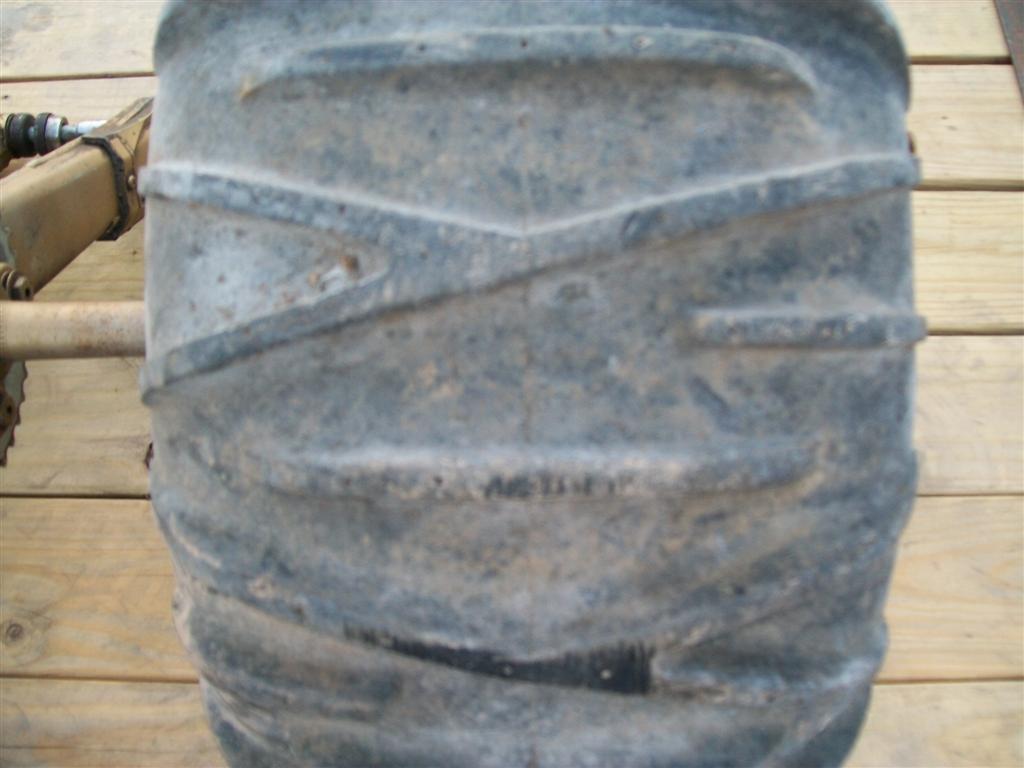
Last edited by a moderator:
How about some pictures of the project completed? What did you ever do about an airbox? How did the pipes finally turn out? Can you pull a wheelie now? How does it feel riding it? Heavy?
How about some pictures of the project completed? What did you ever do about an airbox? How did the pipes finally turn out? Can you pull a wheelie now? How does it feel riding it? Heavy?
I kept the pods, I will keep out of the water from now on.
The pipes are a major problem. I might need to switch to a set of small in-line mufflers. (one per side) I just can't fit everything. I refuse to put any of the pipes below the skid plate line... It's not a trailer queen.. I still go over logs with it.
1st and 2nd gear could always pull a wheelie but the gearing is still way too high. Math wise my top speed is still above 100mph. I was not able to hit 6th gear in less than 1/4 mile. I ordered a 42 rear to put on it. I have all the way up to 50 to play around with.
Alright, two things: first I installed a 42 rear sprocket. Second, I got the exhaust all mocked up. I found a set of D&D megaphone pipes at the cycle yard this weekend. I made a set of collector pipes for the quad. They are all welded up welded and I got the D&Ds stuck on there. I still need to make a mounting bracket for them. Pics below.. I also got a set of "quiet" pipes. They are pretty heavy stock mufflers off a suzuki GV1200. I will make it so I can swap the pipes out for on/off trails. The quad is pretty dirty from riding... I'll be washing it and installing the newer plastics this weekend.
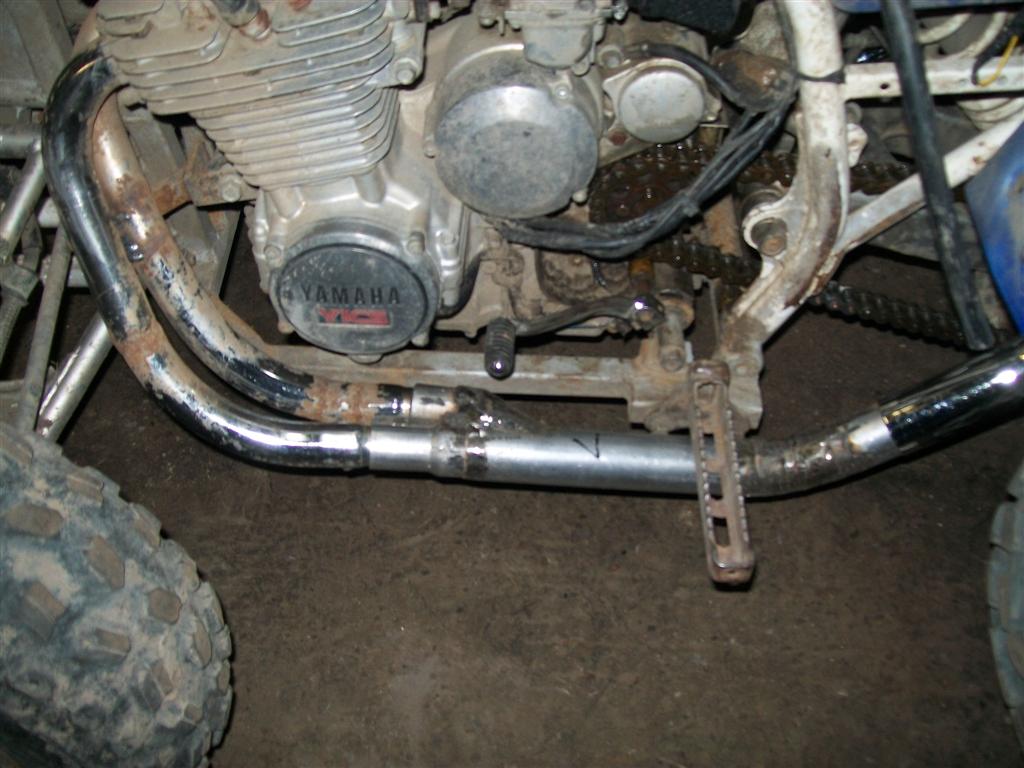
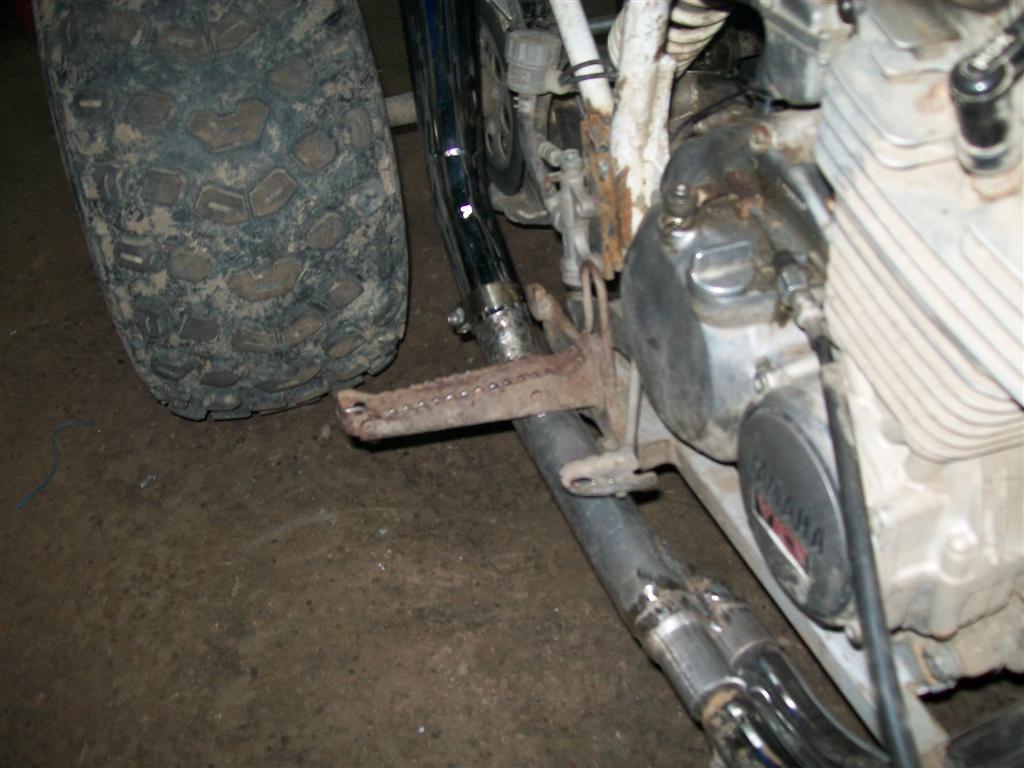
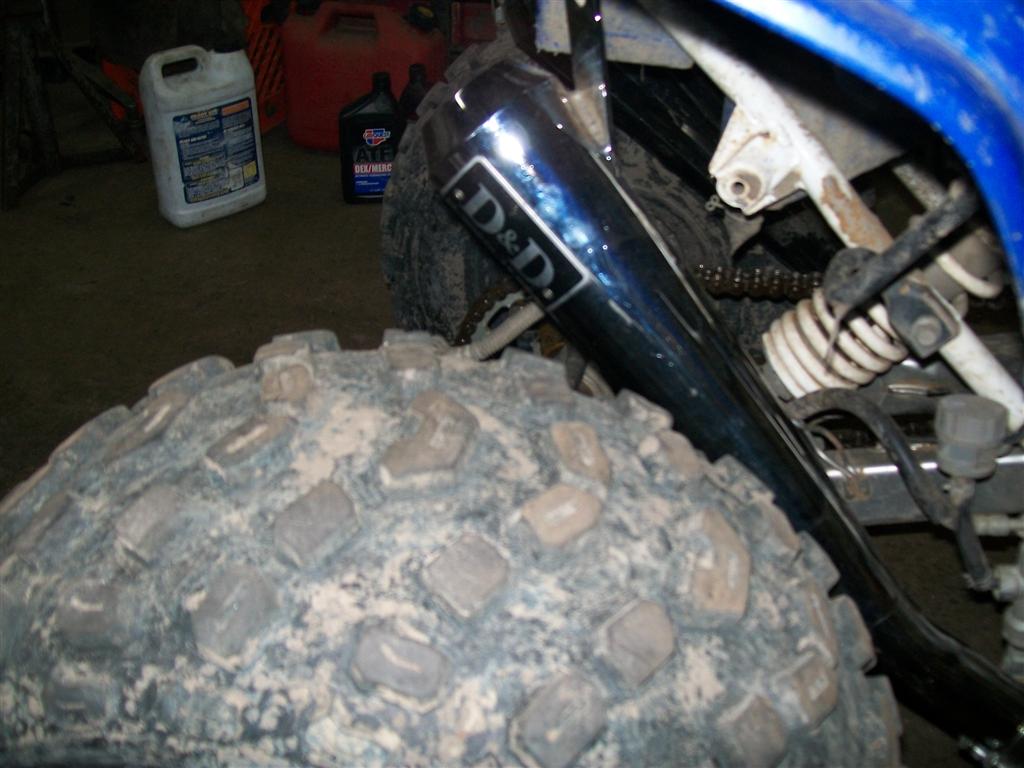
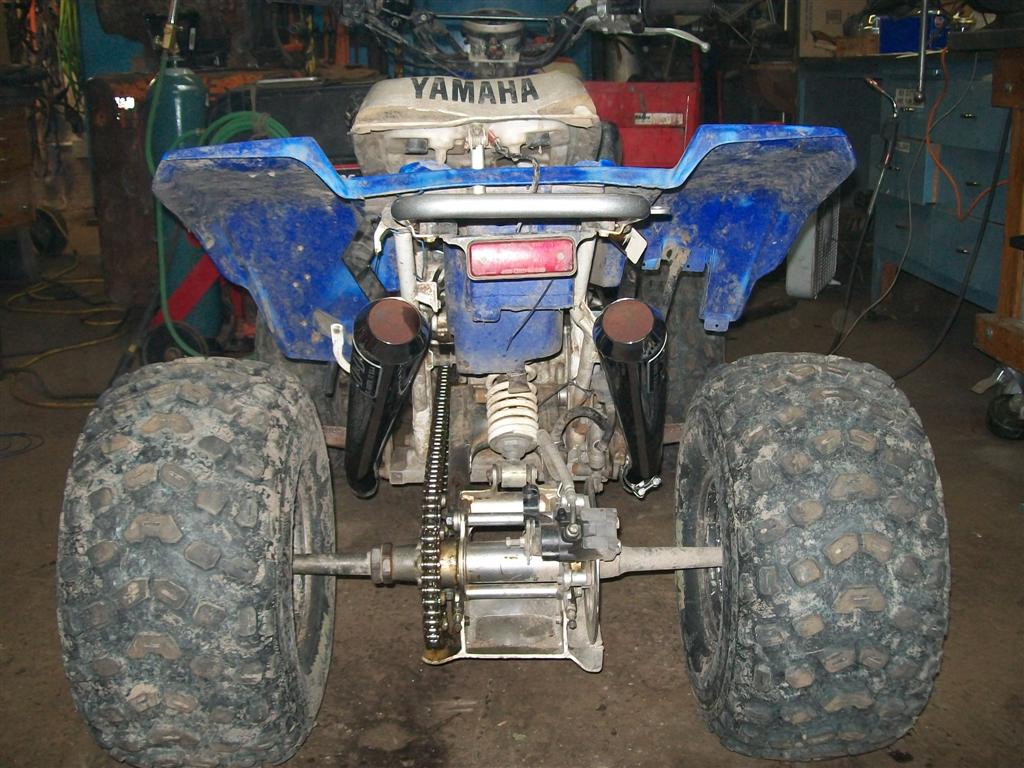
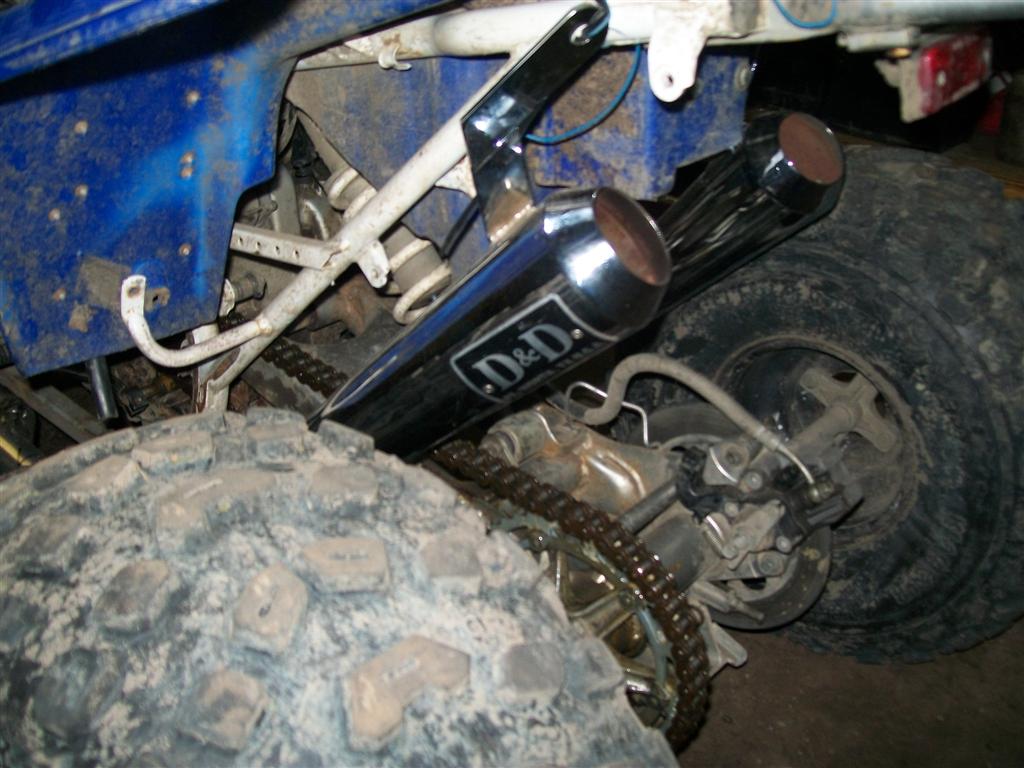
Last edited by a moderator:
Similar threads
- Replies
- 1
- Views
- 791
- Replies
- 1
- Views
- 1K
- Replies
- 1
- Views
- 522
